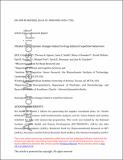Striatal transcriptome changes linked to drug‐induced repetitive behaviors
Author(s)
Crittenden, Jill R.; Gipson, Theresa A.; Smith, Anne C.; Bowden, Hilary A.; Yildirim, Ferah; Fischer, Kyle B.; Yim, Michael; Housman, David E.; Graybiel, Ann M.; ... Show more Show less
Download10.1111-ejn.15116.pdf (699.3Kb)
Open Access Policy
Open Access Policy
Creative Commons Attribution-Noncommercial-Share Alike
Terms of use
Metadata
Show full item recordAbstract
Disruptive or excessive repetitive motor patterns (stereotypies) are cardinal symptoms in numerous neuropsychiatric disorders. Stereotypies are also evoked by psychomotor stimulants such as amphetamine. The acquisition of motor sequences is paralleled by changes in activity patterns in the striatum, and stereotypies have been linked to abnormal plasticity in these reinforcement-related circuits. Here, we designed experiments in mice to identify transcriptomic changes that underlie striatal plasticity occurring alongside the development of drug-induced stereotypic behavior. We identified three schedules of amphetamine treatment inducing different degrees of stereotypy and used bulk RNAseq to compare striatal gene expression changes among groups of mice treated with the different drug-dose schedules and vehicle-treated, cage-mate controls. Mice were identified as naïve, sensitized, or tolerant to drug-induced stereotypy. All drug-treated groups exhibited expression changes in genes that encode members of the extracellular signal-regulated kinase (ERK) cascades known to regulate psychomotor stimulant responses. In the sensitized group with the most prolonged stereotypy, we found dysregulation of 20 genes that were not changed in other groups. Gene set enrichment analysis indicated highly significant overlap with genes regulated by neuregulin 1 (Nrg1). Nrg1 is known to be a schizophrenia and autism susceptibility gene that encodes a ligand for Erb-B receptors, which are involved in neuronal migration, myelination, and cell survival, including that of dopamine-containing neurons. Stimulant abuse is a risk factor for schizophrenia onset, and these two disorders share behavioral stereotypy phenotypes. Our results raise the possibility that drug-induced sensitization of the Nrg1 signaling pathway might underlie these links.
Date issued
2021-03-23Department
McGovern Institute for Brain Research at MIT; Massachusetts Institute of Technology. Department of Brain and Cognitive Sciences; Koch Institute for Integrative Cancer Research at MITJournal
European Journal of Neuroscience
Publisher
Wiley
Citation
Crittenden, JR, Gipson, TA, Smith, AC, et al. Striatal transcriptome changes linked to drug-induced repetitive behaviors. Eur J Neurosci. 2021; 53: 2450– 2468.
Version: Author's final manuscript
ISSN
0953-816X
1460-9568